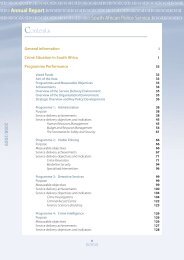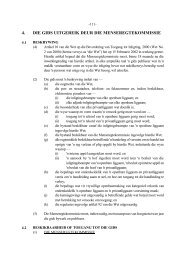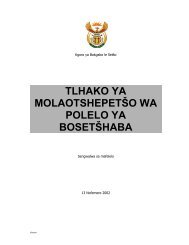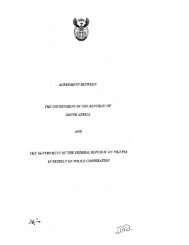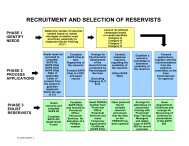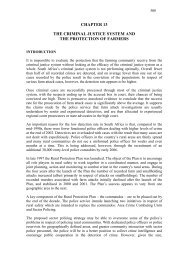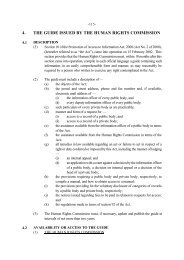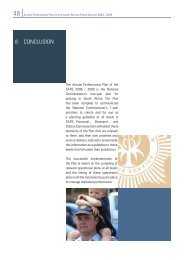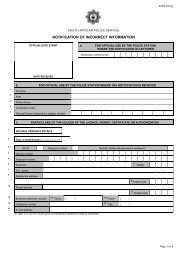Untitled - Saps
Untitled - Saps
Untitled - Saps
You also want an ePaper? Increase the reach of your titles
YUMPU automatically turns print PDFs into web optimized ePapers that Google loves.
86<br />
PROVINCIAL
OVERVIEW<br />
87
INTRODUCTION<br />
On the adoption of the interim Constitution in 1994, the homelands and old development<br />
regions were abolished and integrated into a united South Africa with nine provinces. In<br />
terms of the Constitution the National Commissioner is required to appoint a provincial<br />
commissioner for each province.<br />
National Profile:<br />
The core responsibilities of the provincial commissioners are to prevent, combat and<br />
investigate crime, maintain public order, protect and secure the inhabitants of the provinces<br />
and their property, uphold and enforce the law and manage the SAPS in each province.<br />
Provincial commissioners ensure the implementation of the Operational Priorities and the<br />
Organizational Policing Priorities as set out in the Strategic Plan of the SAPS, the National<br />
Crime Prevention Strategy and the Service Improvement Programme, as well as the<br />
carrying out of relevant policing functions and administrative and support functions within<br />
the province.<br />
As key departmental programmes are implemented at all organizational levels within the<br />
SAPS, all divisional, provincial, area and station commissioners are required to develop<br />
operational plans aimed at addressing crime effectively.<br />
Serious crime levels in South Africa continue to come down or stabilize. When the ratios of<br />
serious crimes are compared over the 10-year period from 1994 to 2004, it is clear that of<br />
the 20 categories of crime, nine of the crimes have decreased, eight have stabilized and three<br />
have increased. Contact crimes (involving the invasion of another person’s personal space)<br />
over the 10-year period show decreases in murder, rape and attempted murder. There has<br />
been a constant and significant decrease of more than 30% in murder between 1994 and<br />
2004. Assault (GBH serious), common assault and other robbery have stabilized. Crimes<br />
that are heavily dependent on police action for detection, such as the possession of illegal<br />
firearms and drug-related crimes, have increased. This positive action has also had a positive<br />
effect on contact crimes. Carjacking, the hijacking of trucks, robbery of cash in transit and<br />
bank robbery have also decreased by more than 30% over the ten-year period. Whereas<br />
these robberies accounted for a quarter (26,6%) of all aggravated robberies since 1996, they<br />
accounted for some 12% of all such robberies in the course of the last year.<br />
Povinces: 9<br />
Police Areas: 43<br />
Police Stations: 1126<br />
Personnel Strength: 112168 Functional Officers, 31982 Civilian, 144150 Total<br />
Population Ratio: 1:415<br />
88
STATISTICS OF SERIOUS CRIME OVER THE FINANCIAL YEARS 1994 - 2004<br />
INCIDENCE OF CRIME<br />
Crime Categories<br />
1994/1995 1995/1996 1996/1997 1997/1998 1998/1999 1999/2000 2000/2001 2001/2002 2002/2003 2003/2004<br />
CONTACT CRIME (CRIMES AGAINST THE PERSON)<br />
Murder 66.9 67.9 62.8 59.5 59.8 52.5 49.8 47.8 47.4 42.7 ↓<br />
Rape 115.3 125.9 126.7 126.2 118.3 122.8 121.0 121.1 115.3 113.7 ↓<br />
Attempted murder 69.1 67.9 70.4 68.4 70.4 65.4 64.4 69.8 78.9 64.8 ↓<br />
Assault GBH (serious) 555.8 563.7 570.4 570.4 566.3 608.1 630.2 589.1 585.9 560.7 ↔<br />
Common assault 516.0 520.5 500.3 489.0 485.0 538.9 569.7 584.3 621.6 605.7 ↔<br />
Robbery with<br />
aggravating circumstances<br />
218.5 195.0 163.0 177.5 220.6 229.5 260.3 260.5 279.2 288.1<br />
Other robbery 84.2 115.4 124.9 133.4 154.7 173.5 206.5 201.3 223.4 206.0 ↔<br />
CONTACT RELATED CRIMES<br />
Arson 28.2 24.3 24.9 24.0 23.9 22.3 20.5 19.5 20.2 19.0 ↓<br />
Malicious damage to property 317.8 327.7 319.8 307.4 307.6 312.0 319.2 324.5 345.6 341.2 ↔<br />
PROPERTY RELATED CRIMES<br />
Housebreaking - residential 596.2 628.9 602.9 611.1 652.7 673.4 694.0 675.3 704.0 645.2 ↔<br />
Housebreaking - non-residential 225.7 220.8 214.7 219.3 224.5 216.2 209.3 194.4 162.8 139.3 ↓<br />
Theft - motor vehicle 272.8 249.3 239.8 249.2 255.9 239.3 229.0 216.1 204.9 190.0 ↓<br />
Theft-out of/from motor vehicle 472.5 484.7 430.4 435.3 452.5 453.9 459.0 444.6 431.0 370.8 ↓<br />
Stock-theft 121.9 109.7 103.5 101.0 98.8 96.2 95.1 92.9 102.7 89.0 ↓<br />
CRIMES HEAVILY DEPENDENT ON POLIE ACTION FOR DETECTION<br />
Illegal possession of firearms 28.3 31.2 31.4 32.5 35.0 35.7 33.8 34.6 34.8 36.3 ↑<br />
Drug related crimes 118.4 99.4 99.5 103.1 94.0 101.3 102.9 118.0 118.4 135.1 ↑<br />
Driving under the influence of<br />
alcohol or drugs<br />
66.2 58.2 60.4 69.8 59.8 60.5 58.4 54.8 48.7 53.7 ↔<br />
OTHER SERIOUS CRIMES<br />
Other thefts 995.5 979.4 924.5 969.3 1051.4 1152.80 1286.70 1281.10 1364.60 1307.40 ↔<br />
Commercial crime 162.5 154.0 153.2 153.7 150.9 157.7 152.4 130.4 123.7 120.4 ↔<br />
Shoplifting 170.9 160.0 152.2 154.3 153.8 153.4 154.9 152.6 151.8 155.0 ↔<br />
Total of all (17) specific crimes<br />
(excluding crimes dependent on<br />
police for detection)<br />
4989.9 4995.0 4784.4 4848.9 5047.3 5268.1 5516.3 5410.8 5562.9 5259.1 ↔<br />
*CRIMES ACCOUNTED FOR UNDER ROBBERY WITH AGGRAVATING CIRCUMSTANCES<br />
Carjacking * * 31.8 31.7 37.6 35.2 34.2 35.4 32.3 29.7 ↓<br />
Hijacking of trucks * * 9.2 11.3 14.6 11.8 10.4 7.4 2.2 1.9 ↓<br />
Robbery of cash in transit * * 0.9 0.6 0.5 0.5 0.4 0.5 0.8 0.4 ↓<br />
Bank robberies * * 1.4 1.1 1.2 1.0 1.1 0.8 0.3 0.1 ↓<br />
↑<br />
INCREASED<br />
STABILISED<br />
DECREASED<br />
↑<br />
↔<br />
↓<br />
89
1995<br />
Provincial Overview<br />
The advent of our new democracy ushered in many challenges that had to be met by<br />
the relatively new and young policing service. The first test was without a doubt the<br />
amalgamation process carried out by the national and provincial management of the South<br />
African Police.<br />
Eastern Cape Provincial Profile:<br />
In Limpopo the amalgamation of four former police agencies, that is, the South African Police,<br />
the Lebowa Police, the Gazankulu Police and the Venda Police began. In Mpumalanga the<br />
different police agencies, namely the former KwaNdebele Police, the KaNgwane Police, the<br />
municipal police and the South African Police (SAP) were amalgamated and in the North<br />
West the Bophuthatswana Police and the South African Police (SAP) were amalgamated into<br />
the SAPS. The amalgamation of the policing agencies of the former Transkei, Ciskei and<br />
the Republic of South Africa (RSA) respectively, into a single, representative police service<br />
commenced in the Eastern Cape. In KwaZululu-Natal the South African Police (SAP) and<br />
KwaZulu Police were amalgamated into the SAPS<br />
The political violence in the KwaZulu-Natal Province peaked in 1994. The violence caused<br />
untold misery to local communities and several peace initiatives were undertaken. Through<br />
concerted efforts of the provincial and the national government, the SAPS and other<br />
role-players, and the establishment of the KwaZulu-Natal Peace Committee under the<br />
KwaZulu-Natal Peace Act, 1995, peace prevailed in KwaZulu-Natal.<br />
The first group of field training officers (FTOs) underwent their training in the provinces in<br />
order to improve basic training to police student constables. FTOs were placed at various<br />
police stations as mentors to new constables appointed in the new SAPS.<br />
South Africa hosted the Rugby World Cup and the SAPS was responsible for the security<br />
of all events. No serious incidents were reported and the event was regarded as the most<br />
successful Rugby World Cup ever.<br />
Police Areas: 8<br />
Police Stations: 177<br />
% of RSA Population: 15 % (7.1 million)<br />
% of RSA Land Surface: 14 % (169 580 sq km)<br />
Location of Provincial Headquarters: Bisho<br />
Personnel Strength Sworn Officers: 13756 Civilian, 2947 Police<br />
Population Ratio: 1:515<br />
90
1996<br />
Provincial Overview<br />
As the SAPS in the provinces evolved, its technology had to mirror the same developmental<br />
process. This led to the implementation of the Crime Administration System and the Data<br />
Information Analysis System (DIAS) to provide crime management information in all<br />
provinces. The radio system in use in the Western Cape was outdated and as a result of<br />
the limited capability and facilities of its technology, response times during critical policing<br />
situations were unacceptable. This prompted the commissioning of the Tafelberg Radio<br />
Trunking System in 1996.<br />
In Limpopo many people who were accused of practising witchcraft were the victims of<br />
violent attacks, which in some cases culminated in murder, assault, damage to property,<br />
etc. Many innocent, law-abiding citizens were brutally killed and their houses set on fire.<br />
The police in the province initiated a rigorous campaign to stop these senseless killings and<br />
managed to bring the situation under control.<br />
To build a bridge between the community and the SAPS Community Policing was<br />
introduced. In terms of the newly adopted style of policing members of the community<br />
were invited to become involved in discussing policing matters in their station area.<br />
Implementation began in all earnest in the provinces with the appointment and training<br />
of provincial coordinators and facilitators who had to firmly establish the practice of<br />
community policing. The success of this strategy ensured that at present police stations<br />
have an established community policing forum and subforums in those areas where the<br />
geography of the area so dictates and that cooperative partnerships are forged between the<br />
SAPS and the community it serves.<br />
Diversity training in the province commenced. The training focused on promoting<br />
cooperation between the different race groups and cultures.<br />
The Resource Establishment Plan (REP) for police stations was introduced in the provinces<br />
for the first time. The REP was aimed at equitably distributing human resources across<br />
South Africa so as to meet the needs of disparate sectors of society. Logistical resources<br />
were redistributed to disadvantaged areas and 4x4 vehicles were issued where areas were<br />
inaccessible by sedan vehicles. Staff representivity in terms of the demographics of the<br />
province at all salary levels was drastically improved.<br />
In an attempt to take service delivery closer to the community and establish environments<br />
that are conducive to helping victims of crime and providing excellent service rendering by<br />
members of the SAPS, numerous police stations were either built or renovated. For example,<br />
in Mpumalanga the Witbank and Groblersdal police stations were officially opened. In<br />
KwaZulu-Natal the Richards Bay, Ntuzuma in KwaMashu and Ezakheni police stations<br />
were built, and the Nsimbini Community Service Centre opened. The Muldersdrift Police<br />
Station was officially opened.<br />
Project Life Line was launched to assist the Service Delivery Improvement Programme<br />
(SDIP) in reaching 100 police stations most in need in South Africa. Provincial, area<br />
and station coordinators were trained to develop integrated provincial, area and station<br />
operational plans.<br />
91
1997<br />
Provincial Overview<br />
In 1997, the SAPS faced the challenge of implementing the White Paper on the<br />
Transformation of Public Service Delivery (Batho Pele). Evaluation questionnaires were<br />
subsequently incorporated into the SAPS Service Delivery Improvement programme<br />
(SDIP) in terms of the Batho Pele Implementation Strategy. A training plan was developed<br />
to target the stations’ management teams and station facilitators were nominated to guide<br />
the process of improving service delivery at stations. The Belgian Gendarmerie also assisted<br />
in the rollout of the SDIP.<br />
Limpopo Provincial Profile:<br />
The Code of Conduct for SAPS personnel was introduced. It set out to unite all police<br />
officials in an attempt to render safety and security in South Africa to all people in an<br />
impartial, courteous, honest, respectful, transparent and accountable manner. In a show of<br />
commitment every member received and signed the Code of Conduct.<br />
Besides Diversity Training being conducted in order for employers and management to<br />
understand issues relating to cultural differences, a Victim Enhancement Programme (VEP)<br />
was launched in the provinces. The latter brought about the understanding among police<br />
officers of the rights of victims and how to deal with victims of crime.<br />
Among the many operational successes countrywide Operation Kliphuis resulted in the<br />
seizure of 56 kg of gold and the arrest of 33 suspects. Operation Mercury led to the arrest of<br />
59 persons and recovery of 64 kg of unwrought gold valued at R2,6 million. In Mpumlanga<br />
police made a breakthrough in a R10 million heist at Marble Hall. Four suspects who had<br />
planned a bank robbery were arrested at Steelpoort.<br />
A new crime scene vehicle for the Local Criminal Record Centre was acquired to investigate<br />
serious crime scenes - this was the first of its kind in South Africa and allowed the SAPS the<br />
mobile ability to physically visit crime scenes while being fully equipped to deal with any<br />
type of scene.<br />
Police Areas: 4<br />
Police Stations: 82<br />
% of RSA Population: 12 % (5.5 million)<br />
% of RSA Land Surface: 10 % (123 910 sq km)<br />
Location of Provincial Headquarters: Polokwane<br />
Personnel Strength Sworn Officers: 7972 Civilian, 1802 Police<br />
Population Ratio: 1:691<br />
92
1998<br />
Provincial Overview<br />
The National Suicide Prevention Project was officially launched in September 1998.<br />
One-day suicide prevention workshops were held in the provinces on a monthly basis.<br />
The helping professions and the hostage negotiators were responsible for implementing<br />
these workshops. The aim of this project is to minimize the number of suicides of SAPS<br />
personnel within the micro-environment and macro-environment, by empowering them to<br />
function in a demanding physical and mental working environment and by developing and<br />
expanding support services to every police official and civilian member. The national suicide<br />
prevention curriculum that was developed was the first and only curriculum of this nature<br />
in South Africa.<br />
Gauteng Provincial Profile:<br />
The building and upgrading of police stations continued. Among other stations the Ekangala<br />
Police station was opened in Mpumalanga and the Ivory Park Police Station in Gauteng.<br />
On 2 January the Kranskop serial killer, Mongani Mfika, was effectively sentenced to 112<br />
years’ imprisonment.<br />
Police Areas: 7<br />
Police Stations: 126<br />
% of RSA Population: 19 % (8.9 million)<br />
% of RSA Land Surface: 1.4 % (17 125 sq km)<br />
Location of Provincial Headquarters: Johannesburg<br />
Personnel Strength Sworn Officers: 24838 Civilian, 7202 Police<br />
Population Ratio: 1:356<br />
Friendship and friendliness is part of the SAPS parcel of service delivery.<br />
93
1999<br />
Provincial Overview<br />
One of the biggest challenges that the SAPS in the Western Cape had to deal with was<br />
urban terror. Intelligence and investigative units had to pool their resources to eradicate a<br />
scourge that was threatening the safety of one of the most popular tourist destinations in<br />
the world. After police officials had been working around the clock, the perpetrators were<br />
finally behind bars, incidents of urban terror abated and Cape Town was rendered safe and<br />
secure.<br />
KwaZulu-Natal Provincial Profile:<br />
A high-density operation, Operation Monozite, was conducted in the province to improve<br />
visible policing, to stabilize high-risk areas and to trace and arrest the ‘most wanted’<br />
criminals.<br />
National Commissioner Jackie Selebi opened Tumahole Police Station at Parys on 5 March<br />
1999. This was the first new police station to be opened in the Free State since 1994.<br />
Douglasdale Police Station was opened in Area Johannesburg on 2 July 1999.<br />
Following the introduction of community policing and the establishment of community<br />
and policing partnerships, the newly established SAPS generated positive attitudes and<br />
confidence among both the public and private sector regarding the ability of the SAPS<br />
to uphold the fundamental rights of all people and contribute to the reconstruction and<br />
development of and reconciliation in South Africa. Many partnerships were forged with,<br />
for example, Business Against Crime. Another project of huge value was initiated by<br />
Phumelela, in terms of which SAPS Mounted Units in Gauteng received donations to the<br />
value of R7 million over 5 years. BMW continued to donate high-speed vehicles for effective<br />
hi-way patrolling in a number of provinces.<br />
The security at the All Africa Games was the responsibility of SAPS Gauteng. No major<br />
incidents were reported and a total of 4 000 SAPS members were involved.<br />
In August, the late Safety and Security Minister Steve Tshwete congratulated 30 police<br />
members on their excellent work in arresting seven suspects before they could commit a<br />
bank robbery in Potchefstroom and on the arrests of suspects linked to the murder of seven<br />
people at Mandela Park squatter camp.<br />
Police Areas: 7<br />
Police Stations: 189<br />
% of RSA Population: 21 % (9.6 million)<br />
% of RSA Land Surface: 8 % (92 100 sq km)<br />
Location of Provincial Headquarters: Durban<br />
Personnel Strength Sworn Officers: 17393 Civilian, 4156 Police<br />
Population Ratio: 1:556<br />
On 22 December the Wemmerpan serial killer, Maupa Cedric Maake, also known as the<br />
hammer murderer, was found guilty on 114 of 133 charges.<br />
94
2000<br />
Provincial Overview<br />
Training in Human Rights and Policing (HRP) was introduced in order to give members<br />
a clear understanding of Human Rights in relation to performing their policing functions.<br />
The Campaign Against Torture project was launched as a pilot project in November 2000,<br />
in conjunction with Amnesty International, which formed part of a worldwide campaign<br />
against torture. More than 40 independent monitors were trained to make unannounced<br />
visits to police stations and assess the treatment of prisoners. Amnesty International paid<br />
tribute to the SAPS for this groundbreaking initiative.<br />
The concept of Sector Policing was introduced in the SAPS whereby policing areas would<br />
be divided into more manageable parts and where sector managers would be appointed to<br />
manage each sector. The principle of sector policing extended the concept of community<br />
partnerships in policing. Sector managers were trained in selecting sector committees and<br />
identifying the root causes of crime. The sectors defined sector policing as “the utilization<br />
of all role-players within a sector in order to address the root causes of crime through a joint<br />
problem-solving approach”.<br />
The mission for sector policing was to:<br />
• Reduce incidents and effects of crime<br />
• Detect and apprehend offenders<br />
• Stabilize crime levels<br />
• Normalize policing<br />
• Initiate crime prevention programmes<br />
The conflict between taxis and the Golden Arrow Bus Company in Cape Town, which<br />
started in April 2000 left several people dead or injured. By December 2000 the hard work<br />
and dedication of SAPS intelligence personnel, investigators and other law enforcement<br />
agencies had led to the arrest of several people, including the gunman, Bandile Botya, who<br />
was later convicted by the Cape High Court. Commuters were free again to use the mode<br />
of transport of their choice without fearing for their lives.<br />
Area Crime Combating Units (ACCUs) were deployed at prioritized stations to support the<br />
Crime Prevention Units. The ACCU assisted with stop-and-search operations, roadblocks,<br />
the arrest of wanted suspects, intelligence-driven operations and crowd management.<br />
The management of crowds involves securing both the safety of demonstrators and spectators<br />
Operation Rhino resulted in the arrest of most of the identified syndicate leaders and<br />
members involved in mainly the illegal smuggling of endangered species, the illicit dealing<br />
in diamonds and vehicle theft (Northern Cape).<br />
In Gauteng the Atteridgeville Police Station and the new Linden Police Station were<br />
officially opened.<br />
Prominent cases that were solved in the North West included the murder of Dr O A Zabadia<br />
in 1996, for which four suspects were arrested, including her husband, and the murder of Dr<br />
M P Manyapelo from Mafikeng in 2000, for which five suspects were arrested, including his<br />
wife who was sentenced to 30 years’ imprisonment.<br />
95
2001<br />
Provincial Overview<br />
A geographical approach to policing was introduced in 2001 by launching in all provinces,<br />
in identified high crime areas, Operation Crackdown. The operation focussed on serious<br />
and violent crimes and set out to reduce high levels of prioritised crimes and stabilise specific<br />
crime tendencies in flash point areas. An intelligence driven approach was followed. Within<br />
six months approximately 260 000 suspects were arrested, 8 377 illegal firearms seized<br />
and 8 886 stolen vehicles recovered, which contributed to the stabilisation of the overall<br />
crime levels.<br />
The Letsema campaign was launched and some 80 000 volunteers from the community<br />
came forward to offer their services in helping with administration, crime prevention, court<br />
duties, business watch and radio control rooms.<br />
Among the many police stations built the Leboeng Police Station in Limpopo, which<br />
forms part of a multipurpose community service centre, added special relief to the local<br />
community who had to go to the far-off Tubatse Police Station to lay complaints. Police<br />
stations were opened in Emzinoni, Hendrina and Volkrust in Mpumalanga. The late<br />
Minister Steve Tshwete opened the Butterworth Police Station in the Eastern Cape. Two<br />
new police stations, namely Tumahole and Mangaung, were established in the Free State<br />
and the new Katlehong, Orange Farms and Zonkizizwe police stations were officially<br />
opened in Gauteng.<br />
The Mpumalanga police achieved a milestone in joining hands with the Amakhosi,<br />
the traditional leaders of the province, who agreed to help combat crime. The House<br />
of Traditional Leaders was established in 1995. The some 50 traditional leaders in<br />
Mpumalanga contributed to crime-fighting by -<br />
• encouraging the communities to report any incidents or suspected incidents of crime to<br />
the police;<br />
• assisting the police by giving information as to the whereabouts of suspected criminals;<br />
and<br />
• initiating programmes to make the community, particularly parents, aware of negative<br />
trends and encouraging them to take precautionary measures.<br />
The late Minister for Safety and Security, Steve Tshwete, launched the national project<br />
on Reject and Report Stolen Goods in Katlehong on 2 April. Provincial launches soon<br />
followed and were also held at, among other venues, Mdantsane. The project intended<br />
to make people aware of the consequences of buying stolen goods and aimed to mobilize<br />
communities to reject and report stolen goods.<br />
In accordance with the organizational mission of serving all communities, officials from<br />
the Cape Town Central Police Station launched a station project for homeless children in<br />
November 2001. Provincial Commissioner M Petros threw his weight behind the project,<br />
which was eventually implemented in all police areas. The purpose of the project was to<br />
redirect the destiny of homeless children, assist them in acquiring skills and knowledge, as<br />
well as to steer them away from crime. This was done through sport, music and culture,<br />
awareness raising, skills development, policing and reunifying them with their families.<br />
A concerted effort was made to crack down on the trafficking of drugs and illicit substances,<br />
and operations were conducted countrywide. In Saldanha Bay, for example, 155 kg of<br />
cocaine worth R325 million was seized.<br />
The SAPS policed the World Conference on Racism and the NAM Health Summit in 2001<br />
and again the SAPS provided proof of the ability to manage and provide security at major,<br />
international events.<br />
A sod-turning ceremony was held in March 2001 in preparation of the building of a one-stop<br />
Community Safety Centre in Centani, Queenstown in the Eastern Cape. The centre would<br />
deliver basic services to communities in rural areas and informal settlements. The centre was<br />
opened in 2004. This centre was the first of its kind in South Africa and housed the SAPS,<br />
the Department of Correctional Services, the Department of Justice, the Department of<br />
Health and the Department of Welfare. The opening was considered a historic occasion as<br />
the centre would for the first time allow members of the community to travel to one single<br />
96
destination to access the services of not only other government departments but also the<br />
police in close proximity to their homes.<br />
Members in the SAPS carry many brave deeds out daily. Three police members, for<br />
example, did not hesitate to rescue three people, including a baby, by helicopter off the<br />
roof of a burning building in Johannesburg. The police rescuers received a certificate of<br />
appreciation.<br />
Free State Provincial Profile:<br />
A Client Service Centre<br />
Police Areas:3<br />
Police Stations: 109<br />
% of RSA Population: 6 % (2.9 million)<br />
% of RSA Land Surface: 11 % (129 480 sq km)<br />
Location of Provincial Headquarters: Bloemfontein<br />
Personnel Strength Sworn Officers: 7941 Civilian, 1650 Police<br />
Population Ratio: 1:371<br />
Policing in the Free State includes border policing in mountainous land<br />
97
2002<br />
Provincial Overview<br />
The World Summit on Sustainable Development (WSSD) in Gauteng, which was policed<br />
by the SAPS, demonstrated South Africa’s ability to host a massive international event<br />
with technical precision, organizational excellence and logistical sophistication. It won<br />
the enduring admiration of the United Nations and the 193 nations represented at the<br />
Summit.<br />
The leader of the Boeremag was arrested in 2001. The Boeremag’s planned coup was<br />
thwarted following the seizure of a truck loaded with explosives in Lichtenburg on 15<br />
September 2002 and the arrest of all suspects.<br />
The Automated Fingerprint Identification System (AFIS) was implemented in the provinces.<br />
All fingerprint forms were searched at the AFIS offices and all crime scene prints were<br />
searched on AFIS, resulting in the identification of hundreds of suspects. The computerised<br />
system drastically decreased the time it previously took to search for fingerprints by means<br />
of a manual hand system..<br />
On 25 May the Bruma Lake murderers, Temba Nkosi and Simon Majola, were sentenced to<br />
375 years and 412 years’ imprisonment respectively. On 18 November the Child Protection<br />
Unit reunited a mother and her son. The son had been stolen 18 years before. A 60-yearold<br />
woman was arrested. On 3 December the NASREC Murderer, Lazarus Mazingane,<br />
also known as the Orange Farm serial killer, was found guilty on 16 counts of murder and<br />
numerous other serious offences. He was sentenced to 17 life sentences and a further 781<br />
years’ imprisonment.<br />
The Phoenix serial killer who was operating in the Phoenix area was responsible for the<br />
death of more than 17 victims. Following lengthy investigations by the Serious and Violent<br />
Crime Unit and with the assistance of a forensic psychologist, the suspect was arrested and<br />
connected to these cases. The suspect was convicted and sentenced to several life sentences.<br />
Police used forensic and other techniques such as facial reconstruction to identify the<br />
victims<br />
In Mpumalanga the Hartbeeskop Police Station was officially opened. The Oranjeweg<br />
Police Station, in the town of Upington in the Northern Cape was also officially opened.<br />
The Khutsong Community Safety Centre, offering policing and other local support services<br />
for the community in a single centre, was opened on 13 September.<br />
The Police Music and Cultural Association (POLMUSCA) was founded in Limpopo in<br />
1992. The first POLMUSCA festival was held in Lebowakgomo, Limpopo in 1992. The<br />
ten-year celebrations of POLMUSCA took place in 2002.<br />
Operation Jody has been implemented since April 2002. The operation focused on abalone<br />
poaching and other, related import and export crime. A task team consisting of members<br />
from the Operational Response Unit, the Organized Crime Unit and Marine and Coastal<br />
Management was formed. Eleven tons of abalone were confiscated in the Eastern Cape.<br />
Polmusca was founded in Limpopo in 1992. Polmusca embodies the SAPS<br />
band and choral arm. Polmusca members today perform countrywide.<br />
98
2003<br />
Provincial Overview<br />
Operation Sethunya was launched in 2003 in all provinces to reduce the proliferation of<br />
illegal firearms and ammunitions in South Africa. A test for legal compliance by individuals<br />
and institutions regarding the Arms and Ammunition Act was conducted. Operations were<br />
also carried out to trace illegal firearms. After a period of one year 25 975 firearms were<br />
confiscated and 1 679 940 rounds of ammunition were seized. Operation Sethunya II was<br />
launched in April 2005. The Minister for Safety and Security called out an amnesty on the<br />
illegal possession of firearms and ammunition, commencing on 1 January 2005 for a period<br />
of 90 days. More than 21 000 illegal firearms were surrendered to the SAPS during this<br />
period and more than 9 000 were confiscated during normal policing action. Subsequently,<br />
the amnesty has been extended by another three months until the end of June 2005. More<br />
than 28 000 legally possessed firearms were voluntarily handed in to the SAPS by the end of<br />
March 2005. A total of 1 million rounds of ammunition were handed in or seized.<br />
One of the Western Cape provincial highlights in the 10-year period was the conceptualization<br />
and implementation of the People-Oriented Sustainable Strategy (POSS). The strategy,<br />
which aims at reducing crime levels, was implemented in 2003. Its effectiveness became<br />
evident when Minister Charles Nqakula released crime statistics in September 2004. Crime<br />
in the province had indeed been significantly reduced.<br />
The Moral Regeneration Movement was launched in Seshego, Limpopo Province. The<br />
movement is aimed at stopping ritual-related murders and contact crimes, and child rape<br />
in particular.<br />
Wakkerstroom and Morgenzon police stations were officially opened in Mpumalanga. In<br />
Gauteng the new Alexandra and Boipatong police stations and the renovated Primrose<br />
Police Station were opened. Two new police stations were built in the Tsolo and Motherwell<br />
presidential areas, while NU1 in Mdantsane underwent major renovations. Another six<br />
new police stations were erected at Joubertina, Butterworth, Mzamba, Elliotdale, Studtis<br />
and Qolora in the Eastern Cape. In KwaZulu-Natal the two Presidential stations, namely<br />
KwaMashu and Indanda, were fully resourced.<br />
New headquarters for Gauteng province (Picture; Courtesy Servamus)<br />
99
The SAPS secured the safety of hundreds of thousands of tourists to<br />
the 2003 Cricket World Cup and also later policed the World Health<br />
Organization Conference, SADC, WCAR and NEPAD conferences.<br />
The Eastern Cape acquired eight URI vehicles to police rural areas in view of the high<br />
incidence of stock theft. The European Union (EU) funded the purchasing of these vehicles<br />
at a cost of R2,5 million. The vehicles were unique in South Africa and could travel on any<br />
road irrespective of its condition.<br />
Mpumalanga Provincial Profile:<br />
The SAPS received gold and bronze PRISA awards for the Gauteng provincial project<br />
called Rebuilding Shattered Lives and the National Women’s Day Protea Flower project.<br />
The public relations campaign Rebuilding Shattered Lives was a direct response to a<br />
disaster that could have divided the nation. It proved unequivocally that public relations and<br />
communication can make a difference.<br />
The SAPS secured the safety of hundreds of thousands of tourists to the 2003 Cricket<br />
World Cup and also later policed the World Health Organization Conference, SADC and<br />
NEPAD conferences.<br />
At all the ports of entry various success were recorded. An example was the Sea Boarder<br />
Unit members confiscating two rubber ducks belonging to Green Peace activists during<br />
the World Summit on Sustainable Development. Operation Driefontein resulted in 30 kg<br />
of gold valued at R3,1 million being seized and 42 arrests made. 131 kg of gold valued at<br />
R10,8 million was recovered and four people arrested at Johannesburg International Airport<br />
on a private jet after they smuggled gold into the country. Collin Greeff was arrested with<br />
50 kg cocaine valued at R22 million. Michele Ferandes Barnades was arrested with 12 kg<br />
cocaine valued at R5,5 million at Johannesburg International Airport. Dube Hlangathi, also<br />
known as the mine-dump child serial killer, was arrested on 41 charges of murder and other<br />
serious offences (the Tina Benade and other murder cases). After months of surveillance<br />
and investigation by Crime Intelligence and Organized Crime Units and the Scorpions into<br />
the smuggling of drugs the units recovered drugs valued at more than R1 billion at Durban<br />
Harbour. The United Nations Drug Enforcement Unit, Portnet and the SAPS also entered<br />
into a partnership to introduce a unique scanner unit where containers are scanned for<br />
contraband.<br />
Police Areas: 3<br />
Police Stations: 91<br />
% of RSA Population: 7 % (3.2 million)<br />
% of RSA Land Surface: 7 % (79 490 sq km)<br />
Location of Provincial Headquarters: Middelburg<br />
Personnel Strength Sworn Officers: 6220 Civilian, 1565 Police<br />
Population Ratio: 1:521<br />
100
2004<br />
Provincial Overview<br />
In 2004 certain units were restructured to ensure better service delivery. Family Violence,<br />
Child Protection and Sexual Offences (FCS) units replaced the Child Protection Unit. The<br />
scope of the new units had been broadened to include family violence and sexual offences.<br />
A further effort to bring the service closer to people resulted in the opening of police stations<br />
in Kleinvlei, Khayelitsha West and Phillippi East in the Western Cape; Rabie Ridge police<br />
station in Gauteng; and the newly built Kuyasa Police Station in Colesberg (Northern<br />
Cape).The Minister for Safety and Security, Mr Charles Nqakula, officially opened<br />
Mangaung Police Station in Bloemfontein on 4 July 2004.<br />
The Steve Vukile Tshwete Police Station in the East London area was officially opened. The<br />
old two-room police station made way for a newly built police station that was erected in<br />
honour of the late Minister for Safety and Security, Steve Vukile Tshwete. The late Minister<br />
Tshwete grew up in Peelton, which falls in the station’s area. The Frankford (Ciskei) Police<br />
Station was, therefore, renamed the Steve Vukile Tshwete Police Station. The Minister for<br />
Safety and Security, Charles Nqakula, opened the building in July 2004. The late Minister’s<br />
wife, Mrs Pam Tshwete, MP, unveiled the name plaque.<br />
Safety and Security Minister Charles Nqakula embracing Mrs Pam Tshwete at the<br />
opening of the Steve Vukile Tshwete Police Station in East London<br />
An European Union-funded programme worth R250 million was launched to facilitate<br />
awareness and educational programmes focusing on crimes against women and children,<br />
including victim empowerment programmes and offender support programmes. A Crimes<br />
against Women and Children programme was launched in Umtata, an area known for its<br />
high rate of crimes against women and children.<br />
The SAPS embarked on a project to establish SAPS career centres in all the provinces. The<br />
centres would serve as a point of entry into the SAPS. Members of the public could visit<br />
static displays depicting the various career paths in the SAPS, and be given guidance on the<br />
skills that need to be acquired to be appointed in these careers. SAPS members were also<br />
able to administer various computerized tests to assist members of the public in determining<br />
the career paths they would be best suited for in the SAPS. The first Career Centre was<br />
opened in Sharpeville, Gauteng. Others were later established in the Western Cape<br />
and KwaZulu-Natal.<br />
URI<br />
101
The SAPS Women’s Network was launched at national level and was followed by launches<br />
at provincial, area and station level. The network aims to enhance the rendering of service<br />
by the SAPS through facilitating greater co-operation, equality and empowerment among<br />
all employees of the SAPS. Activities are aligned to government initiatives to improve the<br />
overall quality of life for women.<br />
Limpopo received an award from the United Nations for a project in which mobile service<br />
centres were built from used trucks to improve service delivery in rural areas. These mobile<br />
centres attracted the attention of the Department of Public Service and Administration and<br />
won the Mpumelelo Excellence Award at national level, paving the way for the international<br />
award. Other departments such as Home Affairs, Health, Welfare and Correctional Services<br />
are now also using the centres to reach rural areas in accordance with the Social Crime<br />
Prevention Strategy. Representatives from police agencies of other countries have visited the<br />
province to study this “best practice”.<br />
As the democracy matured the SAPS has become increasingly recognized by the<br />
international community. The SAPS Ladysmith Zulu dancers undertook a trip to England<br />
to represent South Africa at the Edinburgh Military Tattoo and later travelled to Dubai. The<br />
group not only performed at the Dubai Shopping Festival but also at several venues at the<br />
request of the High Commissioner of South Africa in Dubai. The group was also requested<br />
to perform to international audiences visiting KwaZulu-Natal.<br />
Northern Cape Provincial Profile:<br />
A national Imbizo on the Celebration of 16 Days of Activism of No Violence Against<br />
Women and Children was held at Batho in Bloemfontein. Deputy Safety and Security<br />
Minister Susan Shabangu addressed the audience and the community was given the<br />
opportunity to communicate their crime-related problems. The Minister also held an<br />
Imbizo at Katlehong in Gauteng.<br />
In what became the first ever agreement between two countries of this nature in history,<br />
the SAPS destroyed 133 firearms confiscated by the neighbouring Lesotho Mounted Police<br />
Service. This was the first phase of an ongoing process to destroy all the forfeited firearms<br />
that are still in the safeguarding facilities of the Lesotho Mounted Police.<br />
When the Konings family from the Netherlands returned to South Africa in November<br />
2004, they had nothing but praise for the police. Despite having lost their daughter in the<br />
country, the professional manner in which the investigation into Marlene’s murder was<br />
handled, left an indelible impression on the family. A 36-year-old man was arrested and<br />
sentenced to life imprisonment. Marlene Konings was an exchange student whose skeletal<br />
remains were discovered in the Tradouw Pass near Heidelberg in January 2004.<br />
A nationwide investigation was launched into an Israeli syndicate involved in the smuggling<br />
of human tissue. This was the first of its kind in South Africa. Several arrests were made<br />
and documentary proof obtained. The investigation received extensive international and<br />
national coverage in the media. In Honeydew, Gauteng police again smashed a major drug<br />
syndicate and seized Mandrax valued at R 11 million.<br />
As was the case in other provinces such as Gauteng and KwaZulu-Natal, a Highway Patrol<br />
Unit was established in the Western Cape to prevent incidents of crime on the highways; the<br />
number of incidents subsequently reduced drastically.<br />
Police Areas: 4<br />
Police Stations: 83<br />
% of RSA Population: 1.9 % (0.8 million)<br />
% of RSA Land Surface: 10 % (129 370 sq km)<br />
Location of Provincial Headquarters: Kimberley<br />
Personnel Strength Sworn Officers: 3772 Civilian, 1373 Police<br />
Population Ratio: 1:238<br />
102
The SAPS Women’s Network was launched at national level and was<br />
followed by launches at provincial, area and station level. The network<br />
aims to enhance the rendering of service by the SAPS through facilitating<br />
greater co-operation, equality and empowerment among all employees<br />
of the SAPS. Activities are aligned to government initiatives to improve<br />
the overall quality of life for women.<br />
North West Provincial Profile:<br />
Western Cape Provincial Profile:<br />
Police Areas: 3<br />
Police Stations: 101<br />
% of RSA Population: 8 % (3.8 million)<br />
% of RSA Land Surface: 10 % (116 320 sq km)<br />
Location of Provincial Headquarters: Potchefstroom<br />
Personnel Strength Sworn Officers: 7774 Civilian, 2109 Police<br />
Population Ratio: 1:490<br />
Police Areas: 4<br />
Police Stations: 168<br />
% of RSA Population: 10 % (4.5 million)<br />
% of RSA Land Surface: 10 % (129 370 sq km)<br />
Location of Provincial Headquarters: Cape Town<br />
Personnel Strength Sworn Officers: 14613 Civilian, 4311 Police<br />
Population Ratio: 1:313<br />
103



